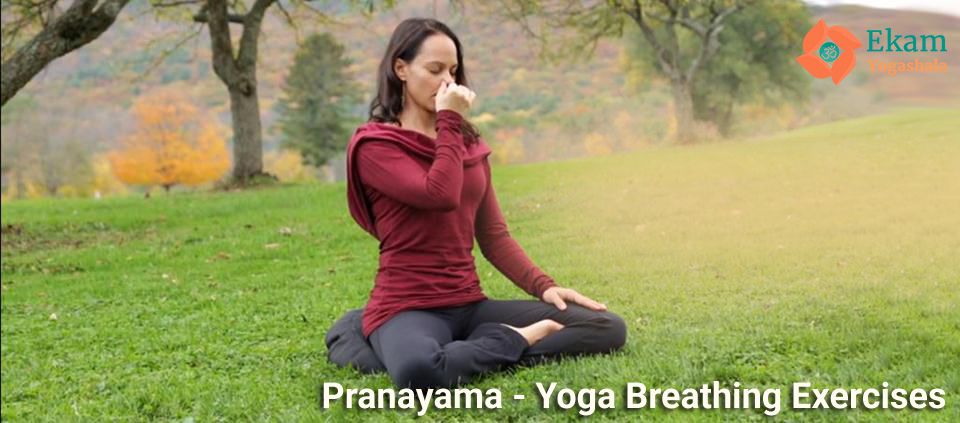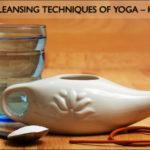Pranayama is one of the eight limbs of the yoga practice and considered as an integral step on the path towards enlightenment. It is one of the way’s to calm and invigorate the body through breathing. It brings consciousness into the

present, bringing mind entirely into breathing. Considered as the fourth limb of Ashtanga Yoga, “Tasmin Sati Svasa Prasavasayorgativicchedah Pranayama” –Regulation of breath or the control of Prana, is the stoppage of inhalation and exhalation, which follows after scoring that steadiness of posture or seat, Asana. (Patanjali, Yoga Sutras, Chapter 11-49).
Pranayama begins with deepening the breathing with the 3-part breath, then into the more advanced form of breathing like Kapalabhati and the Alternate Nostril Breath. Pranayama is performed along with the Asanas. These two yogic principles are deemed as the highest form of purification and self-discipline and a great way to reduce the stress.
Here are some easy ways to do pranayama exercises which beginners can do it with ease
Sama Vritti Pranayama: This exercise is done by taking deep, long and slow breaths in equal duration, this means your breathing pattern is even. Your focus should be completely on inhalation and exhalation. Whenever you are anxious, disconnected, or overwhelmed, perform this breathing exercise, it will stabilize your vata, and will give deep relaxation to your body and mind.
Dirga Pranayama: It is one of the best breathing exercises for beginners. It is very calming and nourishing. In this form of breathing exercise, you take full deep breaths and increase your oxygen supply which will help you to reduce stress and anxiety levels. Besides, you bring awareness to the present moment and calm your mind. This form of three-part breath exercise is used at the beginning of your yoga practice to settle and prepare for practice and meditation.
Nadi Sodhana: In this process, you block off one nostril, exhale and inhale through the open passageway before switching sides. This helps to balance the energy channels on both sides of the body. It provides complete relaxation to the mind and allows it to enter into a meditative state. By practicing Nadi Sodhana only for a few minutes, will help to keep the mind calm, happy and peaceful, and reduce tension and fatigue.
Ujjayi Pranayama: It is a very interesting exercise as it calms the nervous system and boosts oxygen consumption. In this form of exercise, you breathe through your nose, filling the lungs with oxygen while contracting your throat. This breathing exercise is performed throughout Ashtanga and Vinyasa practice, supporting a vigorous flow.
When you have learned to control your breath, you bring peace to your mind and awareness to the present moment. This awareness lies towards the heart of yoga. By regularly practicing breathing exercises, you can improve your emotional health, and link your mind, body, and spirit in the present moment. This unification gives richness and depth to your practice.
Simhasana; Simhasana releases the tension from your face and blows off some steam. In this asana, you manipulate the body to invoke the force and intensity of a lion’s roar. This is one of the best face exercises and also keeps the platysma strong as you grow old. The platysma is a thin, rectangular shaped muscle which is found towards the front of the throat.
Kapalbhati pranayama: This is a much-advanced breathing exercise which is best learned from the experienced teacher. When you perform pranayama, 805 of the toxins in our body are released through the breath, but its regular practice detoxifies all the body systems, resulting in the shinning forehead which signifies overall health.
Kapalbhati pranayama boosts the metabolic rate and weight loss, helps in clearing nadis, improves blood circulation, and digestive tract, energizes the nervous system and calms and uplifts the mind.
So if you practice pranayama, even for few minutes you can remove the impurities from the blood, and the Indriyas by blowing his lungs, etc. by practicing pranayama. So if you are practicing yoga, you should never ignore pranayama.
As Sri Swami Sivananda also says in the Science of Pranayama, “The chief aim of pranayama is to unite the Prana with the Apana and take the united pranapana slowly towards the head. The effect and fruit of Pranayama is Udghata or awakening of the sleeping Kundalini.”











